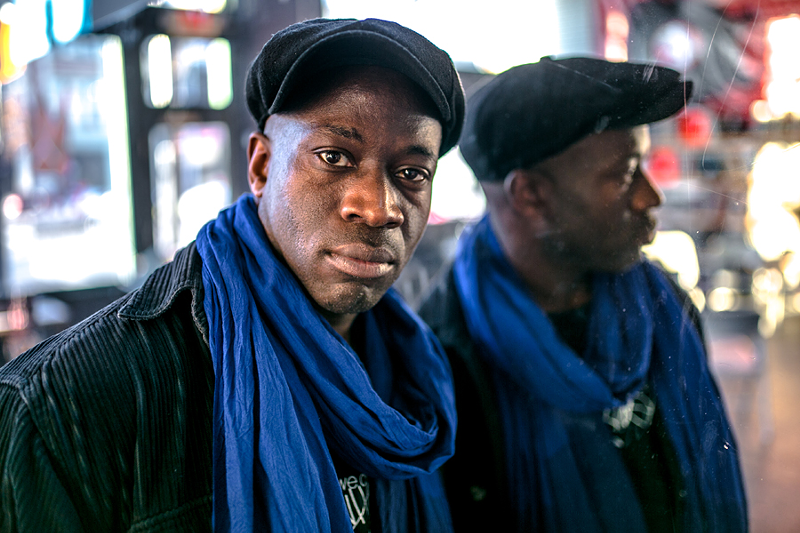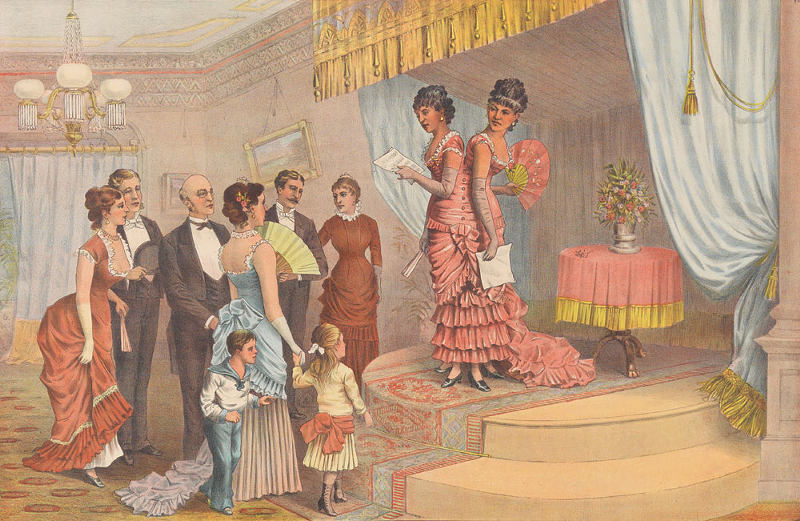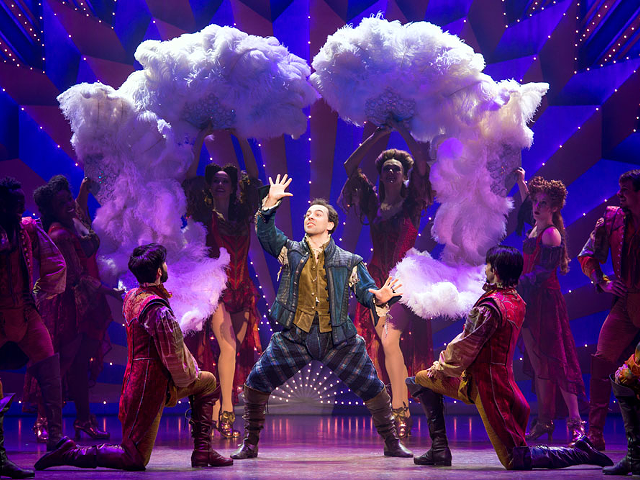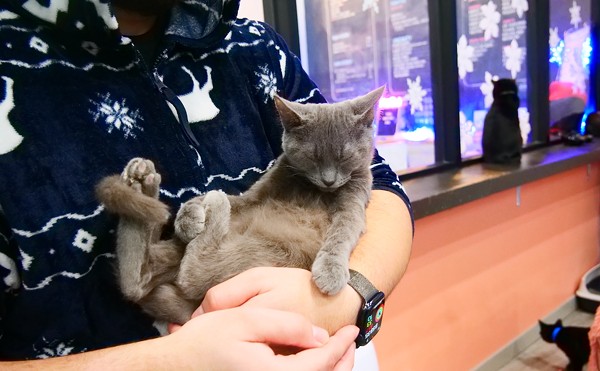Maddox’s multimedia piece, part of CAC’s Black Box Performance Series, retells the story of his great-grandaunts Millie-Christine McKoy, conjoined twins who were born into slavery in 1851 in North Carolina. (Although there is an alternative spelling of their names, Maddox prefers the one used here.) First sold to a showman before they were a year old, and later kidnapped, the sisters became known as “The Eighth Wonder of the World” and “The Two-Headed Nightingale” while touring the United States and Europe as a circus act.
The CAC performance combines song, dance, film, poetry and speculative fiction as it alternately travels back to the 1800s and brings Millie-Christine into the present day. Maddox shares the floor with other local musicians and his frequent collaborator Sorg, a French beatmaker/producer.
Maddox hopes audiences will “think about thinking” as they consider not just what happened to Millie-Christine but how they responded and why. Historical writings by and about the sisters indicate that they proudly celebrated their “other” status a century before Jimi Hendrix ever sang about flying one’s freak flag. When the Emancipation Proclamation ended slavery in 1863, Millie-Christine chose to stay with their white custodians and keep performing music, dance and poetry. In an autobiography, they share their affection not only for one another, but also their owner-turned-manager and the God who made them. Any bitterness seems to be reserved for the doctors who subjected them to public exams to determine whether they were frauds. The sisters learned multiple languages, met Queen Victoria, became successful enough to support both their biological family and their proprietor’s family and gave money to African-American schools and churches before their deaths in 1912 at age 61.
Maddox, who grew up in Cincinnati, first heard the Millie-Christine story from his mother when he was as young as 3. The twins were his maternal grandmother’s aunts. As a child, he never questioned the story’s veracity, but as an adult he realizes there are “multiple truths” to express. Millie-Christine’s existence between exploitation and freedom influences how Maddox thinks about his own “twoness” as a black man living in the United States.
“I see that there is a very real hyphen between ‘African’ and ‘American,’ just like there is a hyphen between ‘Millie’ and ‘Christine,’ ” he says. “I’ve found that really rich to be able to draw from, in terms of identity and confidence and purpose and declaring ‘This is who I am.’ I know I have my place in the universe, or else I wouldn’t be here.” The twins themselves alternated between identifying as two and one, yet they resisted the idea of a surgical end to their dual state.
Maddox recognizes that his great-grandaunts’ self-acceptance and benevolence despite their circumstances can serve as both an example and an irritant for African-Americans and others in 2017. He wonders whether he and his modern audiences unfairly project their own frustrations about inequality onto Millie-Christine in assuming that the sisters covered up anger.
“I’m still figuring out how much of their story will ever be understood and known,” Maddox says. “Because when you are owned, your voice is also owned.”
The matter of being depersonalized is especially troubling to Maddox.
Reality TV and internet videos aside, freak shows are no longer official forms of entertainment. “But in other ways, people are very objectified,” he says. “I think looking at someone else’s supposed oddness or perceiving some of us as ‘the other’ makes some of us feel more secure in our sameness. And, unfortunately, we’re seeing a lot of that right now in the last set of news cycles.”
Twice the First Time was commissioned by the CAC and developed in partnership with France’s Banlieues Bleues Jazz festival, which will stage the piece next month. Maddox, who previously performed A Riot Called Nina, his tribute to singer/activist Nina Simone, at Banlieues Bleues, says the years he’s spent touring, collaborating and teaching Hip Hop around the world opened his eyes to the complexities of identity at home.
“I see myself as a global citizen,” he says. “I’m very aware of and connected to my African heritage, and I know that I have an American passport. I was born and raised here and I vote as an American citizen. But there’s something more to that when you watch the news or walk down the street. I have been arrested because I ‘fit the description,’ and I know that doesn’t happen to every citizen. So that complicates my citizenship.”
Maddox, an education major at the University of Cincinnati, has explored assumptions about identity and “the other” through youth and adult workshops here and overseas. In Italy, he introduced young adolescents to his personal background, U.S. history and Millie-Christine’s tale while talking about perspective, compassion and confidence. The students created a story about how they’d respond to meeting the twins today, considering everything from the kind of seat they’d need to what visitors from the 19th century would eat. Maddox asked the kids whether it was right to assume two people connected would be sad, because the sisters portrayed themselves as happy and beautiful in their poetry. Talking among themselves, the students decided they needed to apologize to Millie-Christine.
“I expected them to get into it, but that (exercise) just made me more excited about the project,” Maddox says. “Twice the First Time is really complex, but my greatest ambition is to feed it in stages so that we move from milk to meat, as it were, in a seamless way. I hope people will still be thinking about it for months or years.”
Maddox, who has spent two years developing Twice the First Time, found a storytelling model in Octavia E. Butler’s 1979 time-travel novel Kindred, about a modern black woman who is repeatedly pulled to the past to save the plantation owner who is also her ancestor. “Kindred gave me a way to talk about existing in two times,” Maddox says. “Some of the poetry I wrote is about how far we’ve come, and what they might say about how far we’ve come, and what little we’ve done about how far we’ve come.”
While Twice the First Time considers how Millie-Christine might react in different periods and how they might respond to the opportunity to join historical figures such as Harriet Tubman, away from the stage Maddox tries to put himself in his great-grandaunts’ shoes in the 1800s.
“How would I have responded? I don’t know,” he says during our interview. He weighs his mature feelings of grace against the rage his younger self would display and explains that everyone likes to say they would have taken the ideal path against injustice.
“Sometimes I hear people talk about how they might not have the due admiration for a person like Dr. (Martin Luther) King, or they may look at a film like The Butler and say, ‘I’m not going to be soft.’ They want to celebrate the Malcolm X character. And I do, too,” Maddox says. “Do I devalue or underestimate the power and the rebellion of Dr. King just because I also respect Malcolm X? Not in the least. I see them as nearly as joined as Millie-Christine.”
Maddox says the only stories we have about Millie-Christine are accounts of being dignified and pleasant. In addition to the performance piece, he is putting together a book that will include a section about the psychology behind Millie-Christine’s path.
Maddox says he can’t imagine the twins didn’t feel frustration and even anger sometimes. “But I don’t see evidence of hatred. I see a lot of evidence of love, which came from themselves and then radiated to ‘the other,’ so that ‘the other’ nearly disappears,” he says. “I think that made them incredibly powerful, and it made them very, very able.”
Hyphenated Millie-Christine realized the power of connection, he says, not just with one another but in the world.
Napoleon Maddox performs TWICE THE FIRST TIME 7:30 p.m. Wednesday through Friday at the Contemporary Arts Center. $15; $10 members. More info: contemporaryartscenter.org.
The 1882 image of Millie-Christine McKoy on CityBeat’s cover was printed by Strobridge Lithographing Co. of Cincinnati and is part of the Cincinnati Art Museum’s permanent collection. In 2011, the museum exhibited it and 79 other prints for the first time in a show titled The Amazing American Circus Poster.From about 1880 to the Great Depression, Strobridge was the leading printer for circus companies. It operated a plant along the Miami-Erie Canal (now Central Parkway) and an office in New York. As demand for circus posters waned around World War II, Strobridge turned its attention to movie ads. In 1961, the company was sold to H.S. Crocker printing. When the business closed 10 years later, it gifted posters to the museum.
Another local printer, The Hennegan Company, also has a tie to Millie-Christine. It published a turn-of-the-century biographical sketch about the conjoined twins, plus other ephemera that caught Napoleon Maddox’s attention during his research for Twice the First Time. He learned that within the last decade or so, the Florence, Ky. company sold its stock of circus materials at auction. “Had I been doing this project (then), I probably could have had in my possession original posters and printed materials,” he says.
The Strobridge poster advertises Millie-Christine as “the most marvellous (sic) human being born since Creation,” echoing a line in their poetry.
“It does praise them, but I wonder about the motivations,” Maddox says. “The illustration looks beautiful, but it’s not really representative of what they looked like. They’re very thin, kind of tall, and look like brown versions of the ideal of Western beauty.”
Maddox says he’s made peace with the idea that creative liberties were taken and that Millie-Christine were lauded for the benefit of the people exhibiting them. He has seen other materials calling them “marvelous monsters.” Both descriptors influenced his development of Twice the First Time, which looks at “the beauty and the ugliness of objectification.”
Strobridge’s poster for Batcheller & Doris’ Great Inter-Ocean circus also stresses Millie-Christine’s “enormous salary” of $25,000 for the season.
“We can see that as one example of the roots of celebrity worship,” Maddox says. “But it was well-documented that they were decent people and the kind of people you’d like to get to know.”
The sum allowed the twins to buy the North Carolina plantation on which they were born and turn it over to their father. The sisters retired there at the end of the 1880s.
A song from Twice the First Time, “All You Got,” addresses celebrity culture then and now. “All you got in your closet don’t matter, man, if you got no soul,” the chorus goes.
Circus posters drew crowds to Millie-Christine because the twins appeared so different. But once patrons were in the sisters’ presence, Maddox says, they got to discover how real they were.
Twins proclaim: ‘I am most wonderfully made’
This poem by Millie-Christine McKoy is part of their autobiography titled The History of the Carolina Twins, Told in “Their Own Peculiar Way” by “One of Them.”
Napoleon Maddox has sampled his great-grandaunts’ writing for some songs in Twice the First Time. “If you had two heads, would you be useless, or do your best not to be fruitless?” one rap goes.
“Their lives were incredibly fruitful,” Maddox says.
’Tis not modest of one’s self to speak,
But, daily scanned from head to feet,
I freely talk of everything,
Sometimes to persons wondering.
Some people say I must be two!
The doctors say it is not true.
Some cry out “humbug,” till they see,
And then exclaim, “great mystery.”
Two heads, four arms, four feet,
All in one perfect body meet.
I am most wonderfully made,
All scientific men have said.
None like me since the days of Eve,
None perhaps shall ever live.
If marvel to myself am I,
Why not to all who pass me by?
I am happy too, because content;
For some wise purpose I was sent.
Our Maker knows what he has done,
Whether I’m created two or one.







